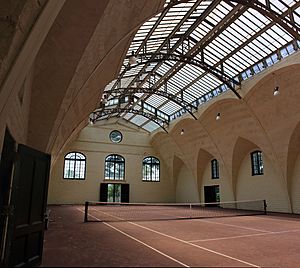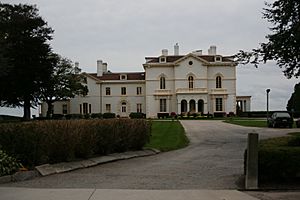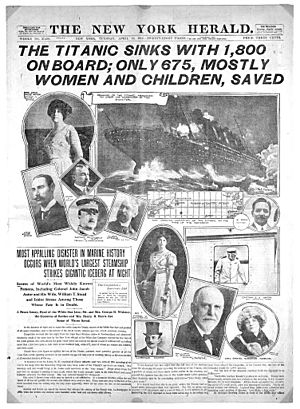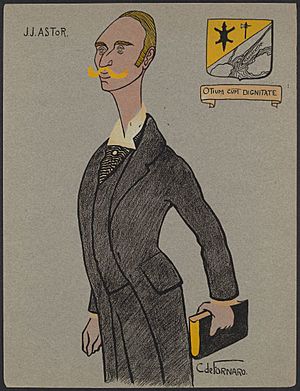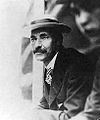John Jacob Astor IV facts for kids
Quick facts for kids
John Jacob Astor IV
|
|
|---|---|
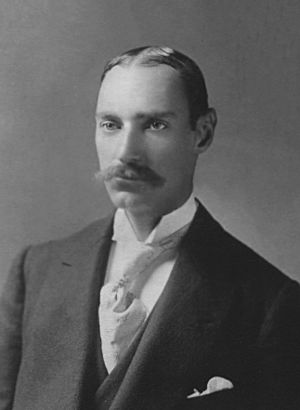
Astor in 1895
|
|
| Born | July 13, 1864 Rhinebeck, New York, U.S.
|
| Died | April 15, 1912 (aged 47) RMS Titanic, North Atlantic Ocean
|
| Resting place | Trinity Church Cemetery, New York City, New York, U.S. |
| Education | St Paul's School |
| Alma mater | Harvard University |
| Net worth | |
| Political party | Republican |
| Spouse(s) | Ava Lowle Willing (1891-1910) (divorced) Madeleine Talmage Force (1911-1912) (his death) |
| Children |
|
| Parent(s) |
|
| Relatives | See Astor family |
John Jacob "Jack" Astor IV (July 13, 1864 – April 15, 1912) was an American businessman, real estate builder, investor, inventor, writer, lieutenant colonel in the Spanish–American War, and a prominent member of the Astor family.
Astor died in the sinking of the RMS Titanic during the early hours of April 15, 1912. Astor was the richest passenger aboard the RMS Titanic and was thought to be among the richest people in the world at that time, with a net worth of nearly $87 million when he died (equivalent to $2.64 billion in 2022).
Careers
Among Astor's accomplishments was A Journey in Other Worlds (1894), a science fiction novel about life in the year 2000 on the planets Saturn and Jupiter. He also patented several inventions, including a bicycle brake in 1898, a "vibratory disintegrator" used to produce gas from peat moss, and a pneumatic road-improver, and he helped develop a turbine engine.
Astor made millions in real estate. In 1897, Astor built the Astoria Hotel, "the world's most luxurious hotel", in New York City, adjoining the Waldorf Hotel owned by Astor's cousin and rival, William. The complex became known as the Waldorf-Astoria Hotel. The Waldorf-Astoria would later be the host location to the U.S. inquiries into the sinking of the RMS Titanic, on which Astor died.
Military service
From 1894 to 1896, he was a colonel on the military staff of New York Governor Levi P. Morton. Shortly after the outbreak of the Spanish–American War in 1898, Astor personally financed a volunteer artillery unit known as the "Astor Battery", which saw service in the Philippines. In May 1898, Astor was appointed a lieutenant colonel in the U.S. Volunteers and served as an officer on the staff of Major General William Shafter in Cuba, during the Santiago Campaign. He was later given a brevet (honorary promotion) to colonel in recognition of his services. He was mustered out of the Volunteer Army in November 1898.
During the war, he allowed his yacht, the Nourmahal, to be used by the U.S. government. He appeared in the films President McKinley's Inspection of Camp Wikoff (1898) and Col. John Jacob Astor, Staff and Veterans of the Spanish–American War (1899). As a result of his military service, Astor was entitled to the Spanish Campaign Medal. After the war, Astor was often referred to as "Colonel Astor."
Astor was a member of several military and hereditary societies. He was an early member of the New York Society of Colonial Wars and was assigned membership number 138. He was also a member of the Military Order of Foreign Wars, Society of the Army of Santiago de Cuba, and the Society of the American Wars of the United States.
Residence
Astor's estate "Ferncliff", north of the town center of Rhinebeck, New York, with a mile and a half of Hudson River frontage in the picturesque Lower Hudson River Valley, had been purchased piecemeal by his father in the mid-19th century; Astor was born there. His father's Italianate house of 1864 was partly rebuilt in 1904 to designs by Stanford White of McKim, Mead, and White, retaining its conservative exterior, and a sports pavilion in Louis XVI style was added. The "Casino" or "Astor Courts" reportedly housed the first residential indoor swimming pool in the U.S., an indoor tennis court with vaulting of Guastavino tile, and guest bedrooms; in the lower level were a bowling alley and a shooting range. The estate, reduced to 50 acres (200,000 m2) and renamed "Astor Courts", eventually became a wedding venue. Chelsea Clinton was wed there on July 31, 2010.
Titanic
While traveling his wife became pregnant. Wanting the child born in the U.S., the Astors boarded the RMS Titanic on her maiden voyage to New York. They embarked in Cherbourg, France, in first class and were the wealthiest passengers aboard. They also took their pet Airedale, Kitty. The Astors were deeply fond of their dog and had come close to losing her on a previous trip when she went missing in Egypt. Kitty did not survive the sinking.
A short while after the Titanic hit the iceberg that caused her to sink, Astor informed his wife of the collision but told her the damage did not appear to be serious. Some time later, as the ship's lifeboats for first class were being manned, Astor remained unperturbed; he and his family played with the mechanical horses in the gymnasium. At some point Astor is thought to have sliced the lining of an extra lifebelt with a pen knife to show his wife its contents, either to prove they were not of use or to reassure her that they were. He even declared: "We are safer here than in that little boat."
When Second Officer Charles Lightoller later arrived on A Deck to finish loading Lifeboat 4, Astor helped his wife, with her maid and nurse, into it. He then asked if he might join his wife because she was in "a delicate condition"; however, Lightoller told him men were not to be allowed to board until all the women and children had been loaded.
After Lifeboat 4 was lowered at 1:55 am, Astor is said to have stood alone while others tried to free the remaining collapsible boats; he was last seen alive on the starboard bridge wing, smoking a cigarette with Jacques Futrelle. A mere half hour later, the ship disappeared beneath the ocean. Survivor Philip Mock claimed to have seen Astor in the water clinging to a raft with William Thomas Stead. "Their feet became frozen," said Mock, "and they were forced to release their hold. Both were drowned." Madeleine Force Astor, her nurse, and her maid survived. Colonel Astor, his valet, Victor Robbins, and Futrelle did not.
In the aftermath, ships were sent out to retrieve the bodies from the site of the sinking; of the 1,517 passengers and crew who perished in the sinking, only 333 bodies were ever recovered. Astor's body was recovered on April 22 by the cable ship Mackay-Bennett. Astor was identified by the initials sewn on the label of his jacket. Among the items found on him was a gold pocket watch which his son Vincent claimed and wore the rest of his life.
Will
Astor left $69 million of his $85 million estate (equivalent to approximately $1.75 billion in 2017 dollars) to his son Vincent. This value included his estate in Rhinebeck and his yacht, the Noma. To Madeleine Force Astor, his wife he left $100,000 as an outright bequest as well as a $5 million trust fund from which she was provided an income. Additionally she was given the use of his New York City mansion at 65th Street & Fifth Avenue and all its furnishings, his Newport mansion Beechwood and all its furnishings, pick of whichever luxury limousine she wanted from his collection, and five of his prized horses—as long as she did not remarry. His daughter Ava (who lived with her mother, also named Ava) received a $10 million trust fund. Upon turning 21, John Jacob VI inherited the $3 million trust fund Astor had set aside for him.
Legacy
According to Walter Lord, "After [the Titanic] sank, the New York American broke the news on April 16 with a lead devoted almost entirely to John Jacob Astor; at the end it mentioned that 1800 others were also lost." Astor's prominence led to the creation of many exaggerated and unsubstantiated accounts about his actions during the sinking of the Titanic. One story alleges that he opened the ship's kennel and released the dogs, including his own beloved Airedale, Kitty; in another, he placed a woman's hat on a boy to make sure the child was able to get into a lifeboat. Another legend claims that after the ship hit the iceberg, he quipped, "I asked for ice, but this is ridiculous." These stories appeared in newspapers, magazines, and even books about the sinking. In reality, none of the claims about Astor's actions were substantiated, as nobody who recognized him survived other than the women who boarded lifeboats relatively early on. Wade wrote that the ice joke is almost certainly apocryphal, as Astor was not known for making jokes, and that the story about the hat (like many other "survivor stories" published shortly after the sinking) may have been invented by the reporter. Another legend is that Astor was crushed to death by one of the ship's falling funnels. However, this legend was not true.
Portrayals
Astor's fame has made him a frequent character in films about the Titanic. German actor Karl Schönböck played Astor in the 1943 Nazi propaganda film Titanic. William Johnstone played Astor in the 1953 film Titanic, and in the 1997 version of Titanic he was played by Eric Braeden. In the 1996 miniseries, he was played by Scott Hylands. Astor was also portrayed by David Janssen in the 1979 film S.O.S. Titanic. Perennially, in the town of Astoria, Oregon (so named for Astor's patrilineal great-grandfather), he is portrayed by a local amateur actor in street corner vignettes. He was played by Miles Richardson in the 2012 Titanic miniseries. In April 2012, Astor was portrayed by his great-grandson Gregory Todd Astor in "Titanic the Musical".
Images for kids
-
John Jacob Astor IV as Henry IV of France
-
Astor and his second wife Madeleine Talmage Force
-
Ferncliff, the Astor family's country estate in Rhinebeck, New York
-
Gold Waltham pocket watch similar to the one Astor wore aboard RMS Titanic
See also
 In Spanish: John Jacob Astor IV para niños
In Spanish: John Jacob Astor IV para niños



